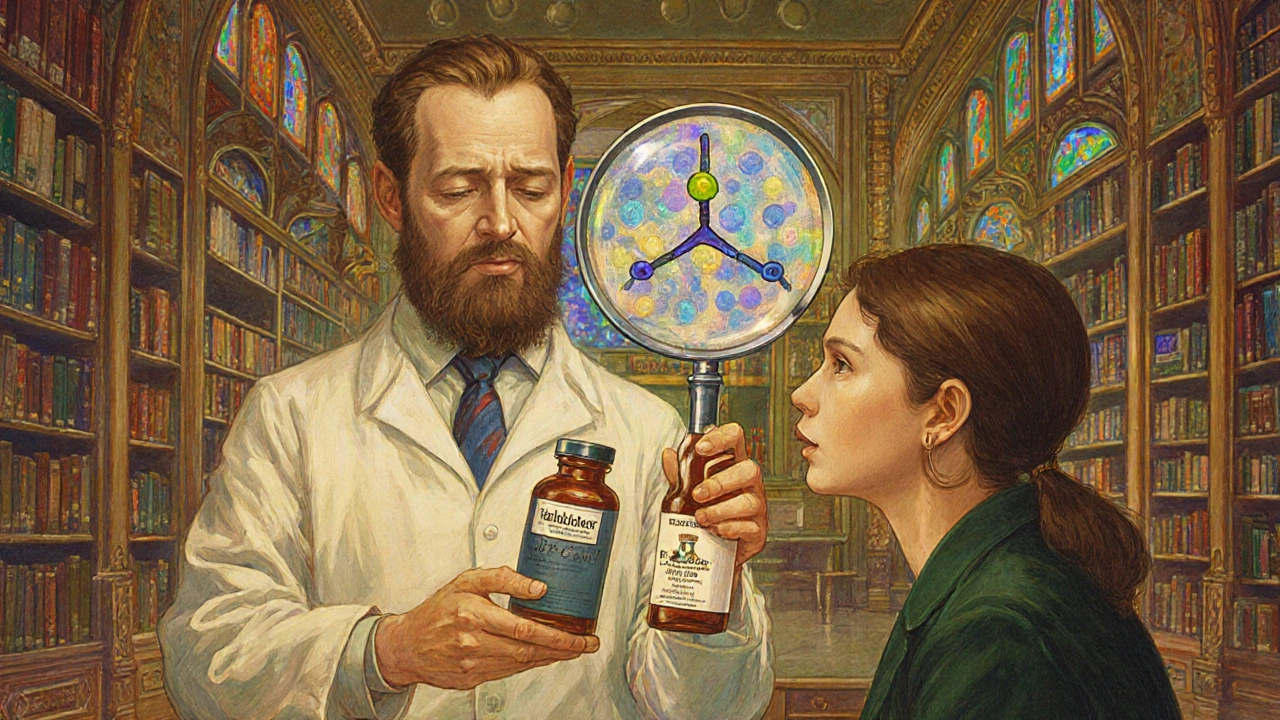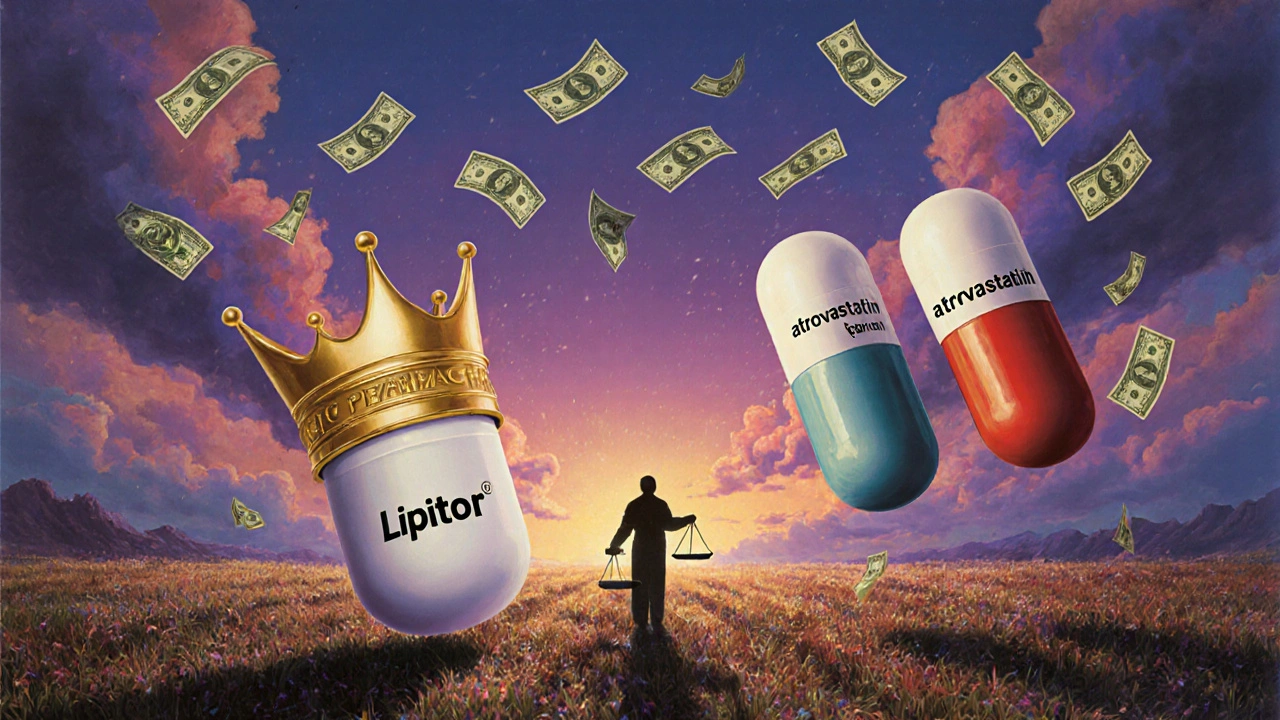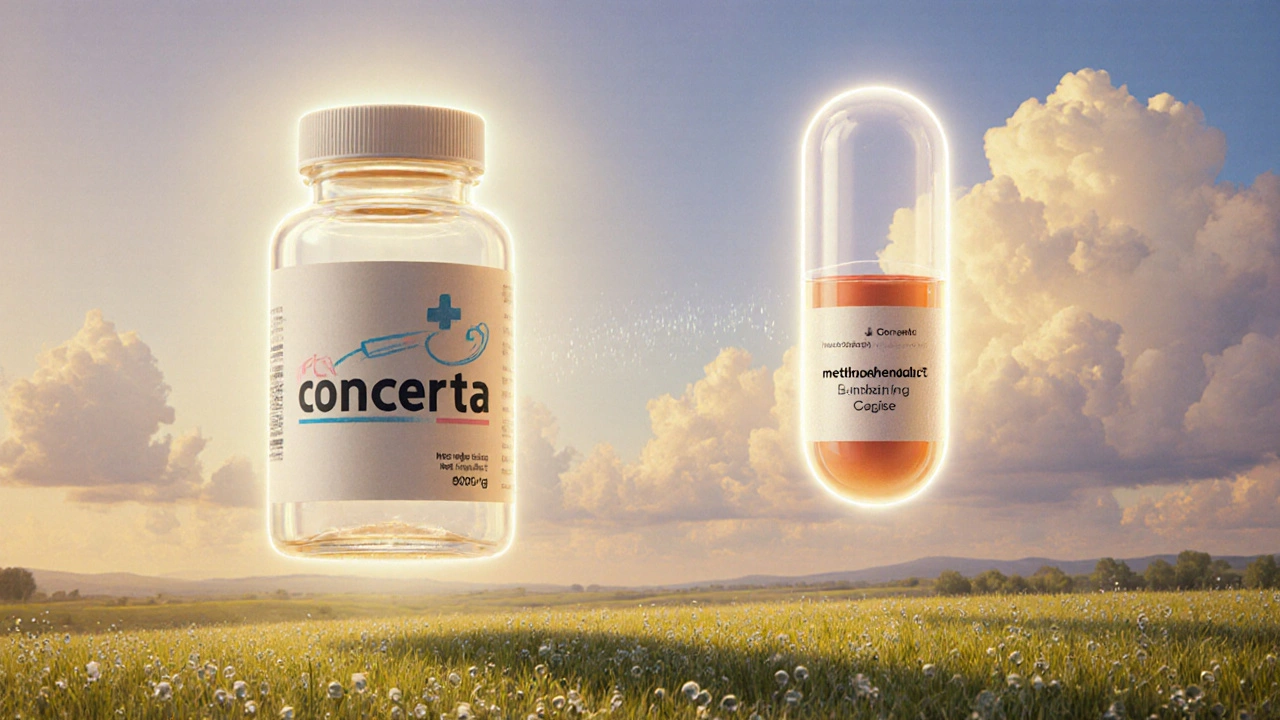When a brand-name drug’s patent runs out, the market doesn’t just open up to cheap generics-it gets messy. That’s where authorized generics come in. These aren’t your typical generics. They’re the exact same pills, capsules, or injections made by the original brand company, just sold without the brand name on the label. No reformulation. No different fillers. No guesswork. If you’ve ever taken Lipitor, Concerta, or Celebrex, you’ve likely taken an authorized generic without knowing it.
What Exactly Is an Authorized Generic?
An authorized generic is a version of a brand-name drug that’s made by the same company that originally developed it. It uses the same active ingredients, the same inactive ingredients, the same manufacturing process, and even the same factory. The only difference? The packaging doesn’t say the brand name. It might say "colchicine" instead of "Colcrys," or "methylphenidate ER" instead of "Concerta." Unlike traditional generics, which must prove they’re "bioequivalent" to the brand through FDA testing (called an ANDA), authorized generics skip that step entirely. They’re approved under the original brand’s New Drug Application (NDA). That means the FDA doesn’t need to re-evaluate them. They’re literally the same product with a different label.Why Do Brand Companies Launch Them?
It’s not charity. It’s strategy. When a patent expires, the first generic manufacturer to file gets 180 days of exclusive rights to sell the generic version under the Hatch-Waxman Act. That’s a huge window to capture market share-and profits. But if the brand company waits until then to respond, they risk losing most of their revenue. So they launch an authorized generic before or during that 180-day window. Suddenly, instead of one low-priced generic entering the market, there are two: the first generic and the brand’s own version. That drives prices down faster. The FTC found that in markets with authorized generics, prices dropped 15-20% more during that critical period than in markets without them. But here’s the twist: the brand company still controls the supply. They’re not giving up the market-they’re just selling it under a cheaper label. And they keep the profit margin. Some estimates show that 42% of top-selling brand drugs launched an authorized generic within six months of patent expiry between 2015 and 2020.Authorized Generics vs. Traditional Generics: The Key Differences
It’s easy to assume all generics are the same. They’re not.| Feature | Authorized Generic | Traditional Generic |
|---|---|---|
| Manufacturer | Original brand company | Separate generic manufacturer |
| Active Ingredients | Identical | Identical |
| Inactive Ingredients | Identical | May differ |
| FDA Approval Path | Under brand’s NDA | Through ANDA |
| Listed in Orange Book? | No | Yes |
| Therapeutic Consistency | Exact match to brand | May vary slightly |

Why Pharmacists and Patients Get Confused
Here’s where things get messy in real life. Authorized generics aren’t listed in the FDA’s Orange Book, which is what pharmacists use to verify therapeutic equivalence. So when a pharmacist receives a prescription for "Celebrex," and the pharmacy dispenses a green capsule labeled "celecoxib," they might assume it’s a traditional generic. But it’s not. It’s the exact same drug, just unlabeled. A 2020 survey in US Pharmacist found that 68% of pharmacists reported patients were confused about the difference. One patient on Drugs.com wrote: "I got this ‘generic’ but it looks identical to the brand I used before-is this actually generic?" That confusion isn’t just annoying. It’s risky. Patients might think they’re getting a cheaper version and assume it’s less effective. Or worse, they might stop taking it because they think it’s "not the real thing." Pharmacies are trying to fix this. Epic Systems added a flag in their 2021 software update to highlight authorized generics in dispensing systems. Pharmacies that used it saw a 67% drop in identification errors.Who Benefits? Who Loses?
The FTC says consumers win-prices drop faster, and patients get the same quality. A 2022 study in Health Affairs found that authorized generics reduced out-of-pocket costs during the 180-day exclusivity window. But critics aren’t convinced. Dr. Jerry Avorn from Harvard called them a "sophisticated market manipulation strategy." The Generic Pharmaceutical Association argues they delay broader competition. If the brand company controls the authorized generic, they’re essentially blocking other generic makers from fully capturing the market. Instead of one low-price generic, you get two: one from the brand and one from a competitor. The brand’s version often gets preferred placement on pharmacy formularies because it’s "the same as the brand." Pharmaceutical companies like PhRMA say authorized generics increase choice. But the data shows most patients don’t even know they’re taking one. A 2005 survey found over 80% of Americans wanted the option-but today, most still don’t understand what they are.
Where Are They Used Most?
Not all drug classes use authorized generics equally. CNS drugs-like those for ADHD, depression, epilepsy, and thyroid disorders-lead the pack. Why? Because even small changes in inactive ingredients can throw off patients. For example, 67% of brand-name CNS drugs with patent expirations between 2015 and 2020 had authorized generics launched within a year. Antibiotics? Only 22%. Why? Because the active ingredient is what matters most. If a patient takes amoxicillin, it doesn’t matter if the filler is cornstarch or lactose. The effect is the same. PBM companies like Express Scripts and OptumRx push authorized generics hard. In 2021, Express Scripts reported 28% higher utilization of authorized generics compared to traditional generics because of their perceived reliability.The Future: More Authorized Generics, More Regulation?
The FDA added 393 new authorized generics to its list between 2020 and 2025. As of October 2025, there are 1,247 on record. Evaluate Pharma predicts that by 2027, 45% of major brand drugs will have authorized generics-up from 32% in 2022. But pressure is building. The "Promoting Competition in Pharmaceutical Markets Act," introduced in Congress in 2023, would ban brand companies from launching authorized generics during the 180-day exclusivity period. If passed, it could change the game. Some experts think the strategy will peak. Bernstein Research says the market will saturate by 2027 as more generic manufacturers enter and the cost of maintaining dual production lines becomes less worth it. Others, like Jefferies Financial Group, believe the trend will continue through 2030.What This Means for You
If you’re on a brand-name drug that’s about to go generic, ask your pharmacist: "Is there an authorized generic available?" It might be cheaper than the traditional generic-and just as reliable. Don’t assume all generics are equal. If you’ve had issues switching from brand to generic before, an authorized generic might be your safest bet. And if you’re confused about what you’re getting, ask for clarification. Your medication shouldn’t be a mystery. The system isn’t perfect. Authorized generics are a clever workaround to a broken patent system. They give patients better access to affordable drugs, but they also let big pharma keep a foot in the door. The real winner? Patients who understand the difference.Are authorized generics the same as the brand-name drug?
Yes. Authorized generics contain the exact same active and inactive ingredients as the brand-name drug. They’re made in the same factory, using the same process. The only difference is the label doesn’t carry the brand name.
Why aren’t authorized generics listed in the FDA’s Orange Book?
Because they’re approved under the brand’s original New Drug Application (NDA), not through the Abbreviated New Drug Application (ANDA) process. The Orange Book only lists drugs approved via ANDA. Authorized generics are considered therapeutically equivalent by the FDA, but they’re not formally categorized in the same way as traditional generics.
Can authorized generics cause different side effects than the brand?
No. Since the ingredients are identical, side effects should be the same. If you’ve had no issues with the brand-name version, switching to the authorized generic shouldn’t change your experience. This is especially important for drugs with a narrow therapeutic index, like levothyroxine or warfarin.
Why do some pharmacies charge more for authorized generics than traditional generics?
Sometimes it’s a billing issue. Authorized generics aren’t always coded the same way in pharmacy systems, so they may default to brand pricing. Ask your pharmacist to check the code. Many insurers treat them like traditional generics, so you should pay the same copay. If you’re being charged more, push back.
How do I know if I’m getting an authorized generic?
Check the label: if it lists the generic name (like "methylphenidate ER") but not the brand name (like "Concerta"), it could be an authorized generic. Ask your pharmacist directly. Some pharmacies now flag them in their systems. You can also search the FDA’s authorized generic list (updated October 2025) or check with the manufacturer’s website.


Kevin Jones
November 18, 2025 AT 19:29Authorized generics are a regulatory loophole dressed as consumer welfare. The FDA’s NDA pathway bypasses bioequivalence testing entirely-so you’re getting the exact same pill, but the brand gets to control the supply chain and pricing dynamics. It’s not competition; it’s monopolistic camouflage.
Premanka Goswami
November 20, 2025 AT 14:13Big Pharma doesn’t want you to know this-but authorized generics are part of a global drug suppression scheme. The same companies that patent drugs then flood the market with their own ‘cheap’ versions to kill independent generics. It’s capitalism with a surgical strike. Wake up.
Saket Sharma
November 21, 2025 AT 11:23Let’s be real-this isn’t about patients. It’s about profit retention. The brand company doesn’t lose market share-they just repackage it under a cheaper label and keep 80% margins. Meanwhile, real generics get squeezed out. This is predatory innovation.
Shravan Jain
November 22, 2025 AT 08:10the fda orange book is a joke. if you dont list it, it doesnt exist. authorized generics are the pharma industry’s way of saying ‘trust us, we’re the same’ while avoiding accountability. also, why do pharmacies charge more for them? someone’s gaming the system.
Brandon Lowi
November 23, 2025 AT 09:14So let me get this straight: American drug companies are allowed to own the brand AND the ‘generic’? That’s not capitalism-it’s corporate feudalism. We’re paying for the same pill twice, once with the brand name, once without-and still getting gouged. This isn’t healthcare. It’s a rigged game.
Joshua Casella
November 23, 2025 AT 12:10For patients on narrow-therapeutic-index drugs like levothyroxine or warfarin, authorized generics are a lifesaver. No formulation changes. No unknown fillers. If you’ve ever had a bad reaction to a traditional generic, this is your safest bet. Ask your pharmacist. Don’t assume all generics are equal.
Richard Couron
November 24, 2025 AT 15:46They say authorized generics lower prices-but who’s really benefiting? The big PBMs? The insurers? Not you. You’re still paying more than you should. And the fact that 68% of pharmacists can’t even tell you what you’re getting? That’s not confusion-that’s systemic failure. Someone’s hiding something.
Alex Boozan
November 26, 2025 AT 00:38Authorized generics are the ultimate Trojan horse. The brand company controls the manufacturing, the distribution, and the perception. They’re not letting competition in-they’re pretending to. This isn’t innovation. It’s a legal cartel. And Congress better ban this before it spreads to every drug class.
mithun mohanta
November 27, 2025 AT 04:44Let’s be honest: if you’re taking an authorized generic, you’re basically getting the brand at a discount-except now you’re the sucker who doesn’t even know it. The real tragedy? You’re paying less, but the system still wins. And you’re still clueless.